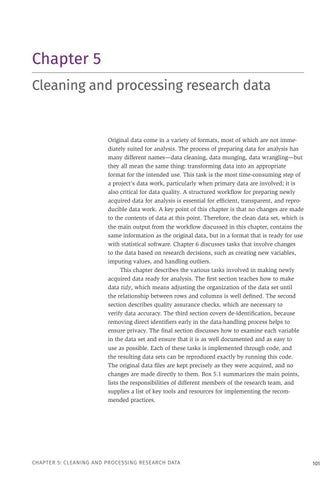Chapter 5 Cleaning and processing research data
Original data come in a variety of formats, most of which are not immediately suited for analysis. The process of preparing data for analysis has many different names—data cleaning, data munging, data wrangling—but they all mean the same thing: transforming data into an appropriate format for the intended use. This task is the most time-consuming step of a project’s data work, particularly when primary data are involved; it is also critical for data quality. A structured workflow for preparing newly acquired data for analysis is essential for efficient, transparent, and reproducible data work. A key point of this chapter is that no changes are made to the contents of data at this point. Therefore, the clean data set, which is the main output from the workflow discussed in this chapter, contains the same information as the original data, but in a format that is ready for use with statistical software. Chapter 6 discusses tasks that involve changes to the data based on research decisions, such as creating new variables, imputing values, and handling outliers. This chapter describes the various tasks involved in making newly acquired data ready for analysis. The first section teaches how to make data tidy, which means adjusting the organization of the data set until the relationship between rows and columns is well defined. The second section describes quality assurance checks, which are necessary to verify data accuracy. The third section covers de-identification, because removing direct identifiers early in the data-handling process helps to ensure privacy. The final section discusses how to examine each variable in the data set and ensure that it is as well documented and as easy to use as possible. Each of these tasks is implemented through code, and the resulting data sets can be reproduced exactly by running this code. The original data files are kept precisely as they were acquired, and no changes are made directly to them. Box 5.1 summarizes the main points, lists the responsibilities of different members of the research team, and supplies a list of key tools and resources for implementing the recommended practices.
CHAPTER 5: CLEANING AND PROCESSING RESEARCH DATA
101





